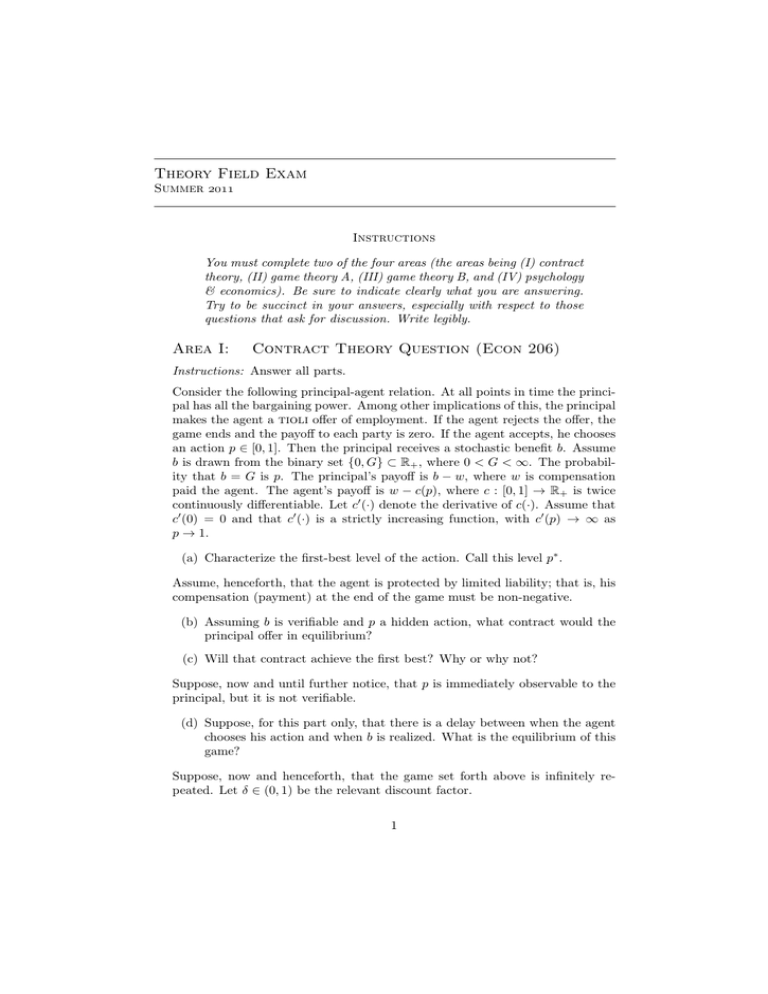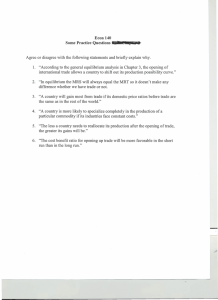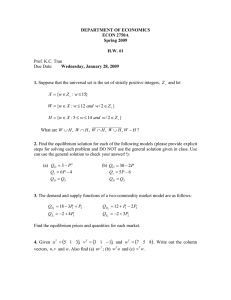Advanced Theory Field Exam, August 2011
advertisement

Theory Field Exam
Summer
Instructions
You must complete two of the four areas (the areas being (I) contract
theory, (II) game theory A, (III) game theory B, and (IV) psychology
& economics). Be sure to indicate clearly what you are answering.
Try to be succinct in your answers, especially with respect to those
questions that ask for discussion. Write legibly.
Area I:
Contract Theory Question (Econ 206)
Instructions: Answer all parts.
Consider the following principal-agent relation. At all points in time the principal has all the bargaining power. Among other implications of this, the principal
makes the agent a tioli offer of employment. If the agent rejects the offer, the
game ends and the payoff to each party is zero. If the agent accepts, he chooses
an action p ∈ [0, 1]. Then the principal receives a stochastic benefit b. Assume
b is drawn from the binary set {0, G} ⊂ R+ , where 0 < G < ∞. The probability that b = G is p. The principal’s payoff is b − w, where w is compensation
paid the agent. The agent’s payoff is w − c(p), where c : [0, 1] → R+ is twice
continuously differentiable. Let c′ (·) denote the derivative of c(·). Assume that
c′ (0) = 0 and that c′ (·) is a strictly increasing function, with c′ (p) → ∞ as
p → 1.
(a) Characterize the first-best level of the action. Call this level p∗ .
Assume, henceforth, that the agent is protected by limited liability; that is, his
compensation (payment) at the end of the game must be non-negative.
(b) Assuming b is verifiable and p a hidden action, what contract would the
principal offer in equilibrium?
(c) Will that contract achieve the first best? Why or why not?
Suppose, now and until further notice, that p is immediately observable to the
principal, but it is not verifiable.
(d) Suppose, for this part only, that there is a delay between when the agent
chooses his action and when b is realized. What is the equilibrium of this
game?
Suppose, now and henceforth, that the game set forth above is infinitely repeated. Let δ ∈ (0, 1) be the relevant discount factor.
1
AREA I:
CONTRACT THEORY QUESTION (ECON 206)
(e) Suppose, for this part only, that b is not verifiable (indeed, b may not
even be observable to the agent). Derive a subgame-perfect equilibrium of
the repeated game, with appropriate conditions on δ, such that the agent
chooses p∗ in every period on the equilibrium path.
(f) Return to the assumption that b is verifiable. How does this change your
analysis in part (e)? Discuss briefly.
Suppose, now, that p is once again a hidden action. Assume that b is observable,
but not verifiable.
(g) Derive a subgame-perfect equilibrium of the repeated game, with appropriate conditions on δ, in which the agent chooses p > 0 in every period
on the equilibrium path.
Page 2 of 8 Pages
AREA II:
Area II:
GAME THEORY A (ECON 207B)
Game Theory A (Econ 207B)
Instructions: Answer both of the following questions.
Question 1: Social Learning with Three Agents
• Three agents i = A, B, C are bound together by a social network and
can only observe the agents to whom they are connected through the
network. The social network is represented by a directed graph in which
nodes correspond to agents and agent i can observe agent j if there is an
edge leading from node i to node j.
• Time is represented by a countable set of dates indexed by t. Each agent i
receives a private (unobserved by others) signal ωi before date 1. The ωi ’s
’s are uniformly distributed on the interval [−1, 1]. There are two actions
a = 0, 1 and the homogenous payoff function is assumed to satisfy
{
0
if a = 0
u(a, ω) =
.
ωA + ωB + ωC if a = 1
• At the beginning of each date t, agents choose actions simultaneously.
Then each agent i observes the actions ajt chosen by the agents to whom
she is connected by the network. Agent i chooses the action ait to maximize the expectation of his short-run payoff conditional on the information
available.
(a) Consider the complete network, in which each agent can observe the other
two. Show that the learning process comes to a halt by the end of the
period 2 at the latest. Does the so-called herd always adopt the action
that is optimal relative to the total information available to agents?
(b) Consider the circle, in which each agent observes one other agent. Show
that alternating actions may continue beyond period 2. Will all agents
choose the same action in finite time with probability one? If everyone
eventually adopts the same action, can the action chosen be sub-optimal?
Question 2: A Simple Homophily Model Consider an economy consisting
of two groups where nk is the size of group k = 1, 2 and assume that n1 > n2 .
The social network is represented by an undirected graph (the relations between
any pairs of nodes is symmetric so that each edge points in both directions).
Let di be the number of neighbors of agent i and let si ≤ di be the the number
of neighbors that agent i has in his own group. Then, a simply homophily index
for group k is given by
∑
si
hk = ∑i∈k .
d
i∈k i
(a) Show that if 0 < hk < 1 for k = 1, 2 and the average degree in group 1 is
at least as high as that of group 2 then h1 > h2 .
Page 3 of 8 Pages
AREA II:
GAME THEORY A (ECON 207B)
(b) What are h1 and h2 when neighborhoods are formed in percentages that
correspond to the shares of the two groups in the total population?
(c) How your answers to questions 1 and 2 change if the social network is
represented by a directed graph?
Page 4 of 8 Pages
AREA III:
Area III:
GAME THEORY B (ECON 209A)
Game Theory B (Econ 209A)
Instructions: Answer all three of the following questions.
Question 1: Consider the variant of the Hawk-Dove game
D
H
D
1, 1
2, 0
H
0, 2
1 − c, 1 − c
(when c > 1 the game has the standard Hawk-Dove structure).
(a) Find the set of all Nash and trembling hand perfect equilibria for all values
of c. Are the equilibrium strategies evolutionary stable?
(b) Let α∗ be an evolutionary stable strategy. Does α∗ necessarily weakly
dominates every other strategy? Is it possible that some strategy weakly
dominates α∗ ? Does it matter if α∗ is pure or mixed?
Question 2: Consider a two-player extensive game of perfect information
where player 1 moves only at the start of the game and player 2 moves once after
player 1. Denote by Si the set of pure strategies available for player i = 1, 2.
(a) Suppose that player 2 is never indifferent between pairs of outcomes, and
that if the two players move simultaneously, then there exist a unique pure
strategy Nash equilibrium in which the payoffs are (ω1 , ω2 ). Show that
player 1’s payoff in any subgame perfect equilibrium of the extensive game
is at least ω1 .
(b) Show by counter-examples that (i) if player 2 is indifferent between a pair
of outcomes or (ii) the strategic game has a unique mixed strategy Nash
equilibrium, then player 1’s subgame perfect equilibrium payoff can be
lower than ω1 .
Question 3: A bargaining problem is a pair ⟨S, d⟩ where S ⊂ R2 is compact
and convex, d ∈ S and there exists s ∈ S such that si > di for i = 1, 2. The set
of all bargaining problems ⟨S, d⟩ is denoted by B. A bargaining solution is a
function f : B → R2 such that f assigns to each bargaining problem ⟨S, d⟩ ∈ B
a unique element in S.
(a) Show that Kalai bargaining solution
f K (S, d) = {s1 = s2 : s ∈ S} ∩ W P O(S)
does not satisfy IN V .
Page 5 of 8 Pages
AREA III:
GAME THEORY B (ECON 209A)
(b) Show that Kalai-Smorodinsky bargaining solution
f KS (S, d) = {
s1
s2
=
: s ∈ S} ∩ W P O(S)
s̄1
s̄2
where s̄i is player i’s the maximum utility does not satisfy IIA.
Page 6 of 8 Pages
AREA IV:
Area IV:
PSYCHOLOGY AND ECONOMICS QUESTION (ECON 219A)
Psychology and Economics Question (Econ
219A)
Instructions: Depending on how you count, there are 36 parts to this question,
so manage your time properly to have plenty of time for other material, and
don’t sweat not getting through this. Certainly do Part I before Part II.
Part I
Max will live for 3 periods. He has $y ≥ 0 to spend on consumption in his
life; he has the money initially, and can freely save it at no interest. Max has
no long-term discounting, so δ = 1 everywhere below.
His utility functions in each of the three periods are given by:
u1 = ln (c1 −c0 ) = ln (c1 ),
u2 = ln (c2 −c1 ),
u3 = ln (c3 +c2 ),
where c0 = 0 by assumption throughout. Max has habit-forming preferences,
where his pleasure from consumption is solely relative to the previous period’s
consumption, and it is as if he were born with no past consumption.
Max chooses consumption levels each period, without commitment. Because
he will simply choose c3 = y − c1 − c2 in period 3, he is essentially only making
choices in periods 1 and 2.
This problem simply asks you to solve for Max’s behavior for each of 6
different personalities he can have, depending on his present bias, sophistication
about that present bias, and projection bias. In each case, you’ll be asked to
solve for his lifetime consumption profile as a function of y. You should circle
your answer to each part to the prediction by filling in “(c∗1 , c∗2 , c∗3 ) =
”.
But for each case, you also must state and circle the maximization problem
the person is doing in each of the two substantive periods: “In Period 2, Max
will choose c∗2 = arg max
”, where this will of course take y and c1 as
given (since Max will have y − c1 in savings). And then describe his Period1 maximization problem similarly, where Max will clearly embed a prediction
of his c2 and c3 . That is, write “In period 1, Max will choose c∗1 = arg max
” where your expression must include nothing but y.
Two important notes:
1) There should not be any quadratic equations or nasty math
involved, every case ought eventually simplify to easy algebra (and
the answers should always be rational numbers). If you are not able
to simplify it thusly, either you are in error, or the question is in
error; you should move without too much time; but
2) some maximization problems may make relatively little sense—
there may not be a well-defined answer to some parts of some questions. If you decide that some part is indeterminant, say so; and
Page 7 of 8 Pages
AREA IV:
PSYCHOLOGY AND ECONOMICS QUESTION (ECON 219A)
answer the questions you can. All math here is reflecting an underlying choice problem, so don’t punt on giving answers to parts that
there is a logical and determinant answer for.
Remember, for each of the 6 parts below, be sure to circle exactly and only
each of three answers (in any order): 1) “(c∗1 , c∗2 , c∗3 ) =
”, 2) “In period
2, Max will choose c∗2 = arg max
”, 3) “In period 1, Max will choose
”.
c∗1 = arg max
The 6 different personalities Max can have are:
a) Max is fully rational, with no present bias and no projection
bias.
b) Max has no present bias, but he has full projection bias, where
each period t he projects his current state of habit level, ct−1 , on
to future periods.
c) Max has no projection bias, but is present biased, with β = 21 .
Max is naive about this present bias.
d) Max has no projection bias, but is present biased, with β = 12 .
Max is sophisticated about this present bias.
e) Max has both full projection bias and is present biased, with
β = 12 . Max is naive about this present bias.
f) Max has both full projection bias and is present biased, with
β = 12 . Max is sophisticated about this present bias.
Please don’t mess up the order (e.g., reverse sophisticate vs. naivety
swers); or, as a safeguard, repeat Max’s personality when you present the
swers. You don’t need to explain or interpret your answers except if you
worried they are ambiguous—devote all your intuition to making sure you
the right answers. And always circle exactly and only intended answers.
ananare
get
Part II
Now we consider the same 6 personalities of Max, with the same utility
function as above. But now we assume that Max lives in a world where there
is 100% interest between periods. This means that if he consumes c1 in period
1, he’ll have savings of (2(y − c1 ) going into period 2, and (more importantly)
if he consumes c1 and c2 , then his savings entering period 3, and hence his
consumption c3 , will be s3 = c3 = 4y − 4c1 − 2c2 .
So re-do (a) through (f) in this new situation.
Page 8 of 8 Pages
Economics 234A Financial economics
Consider an endowment economy where exogenous log consumption ct = log Ct follows
ct+1 = ct +
and "t+1
N 0;
2
+ "t+1
is i.i.d. over time. The representative consumer solves
max Et
1
X
j=0
j
1
Ct+j
1
:
(a) Using the formula for the expected value of a lognormal random variable, compute m =
log [Et Ct+1 =Ct ] the log expected growth rate of consumption.
(b) Write down a stochastic discount factor at period t. Suppose there is a riskfree asset in
zero net supply and compute the log riskfree return rf .
In this economy, the stock market can be represented as a claim to all future endowments,
i.e., the Lucas tree. Denote the price of this asset in period t by Pt . For the remainder of the
problem, assume that Ct = (Pt + Ct ) = b is a constant over time, where b can be interpreted as
the consumption to wealth ratio. This assumption implies that the price of the Lucas tree is a
constant multiple of the single state variable Ct .
(c) Consider the investment of purchasing the Lucas tree at time t. Express the payo¤ of this
investment at period t + 1 as a function of Ct+1 and b. Express the price of this investment Pt
as a function of Ct and b. Combine these to get the return on the Lucas tree 1 + Rt+1 . What
is r2 , the variance of the log return rt+1 ?
(d) Write down the key asset pricing equation for 1 + Rt+1 , take logs and evaluate the expectation to compute log (1 b) with exogenous variables. Note, you can now express Pt with
exogenous variables.
(e) Use the loglinear Euler equation for Rt+1 to compute the equity premium Ert+1 rf +
and combine this with (b) to get the expected stock return ERt+1 Ert+1 + r2 =2.
2
r =2,
Now we add unlikely disasters to this model. For the rest of the problem, suppose that log
consumption follows
ct+1 = ct + + "t+1 + vt+1
with "t+1 N (0; 2 ) i.i.d., where vt+1 equals zero with probability 1 p and log [1 d] with
probability p, 1 > d
0 and p
0 is a small number. Here t+1 can be interpreted as an
unlikely “disaster” event where consumption drops by d percent. We assume that " and are
independent, and that the representative consumer has CRRA preferences as above.
(f) Compute an expression for m = log [Et Ct+1 =Ct ] the log growth rate of consumption, using
the fact that for small x, log (1 x)
x. Compare your result with (a).
(g) Write down the SDF in period t. Express rf using the approximation for the log function
the same way as in (f). Is the riskfree rate higher or lower than in (b)? Why?
1
(h) Consider the risky asset which is a claim to next period’s total endowment Ct+1 . Express
the price of this asset, Pt , with the key asset pricing equation. Compute log [Pt =Ct ].
(i) Show that logE[1 + Rt+1 ] = logE[Ct+1 =Ct ] log [Pt =Ct ], and express this quantity using
your results. Compute the expected excess return ERt+1 Rf logE[1 + Rt+1 ] rf . Compare
your result to the expected excess return in (e). Is the equity premium higher now? Why?
2



